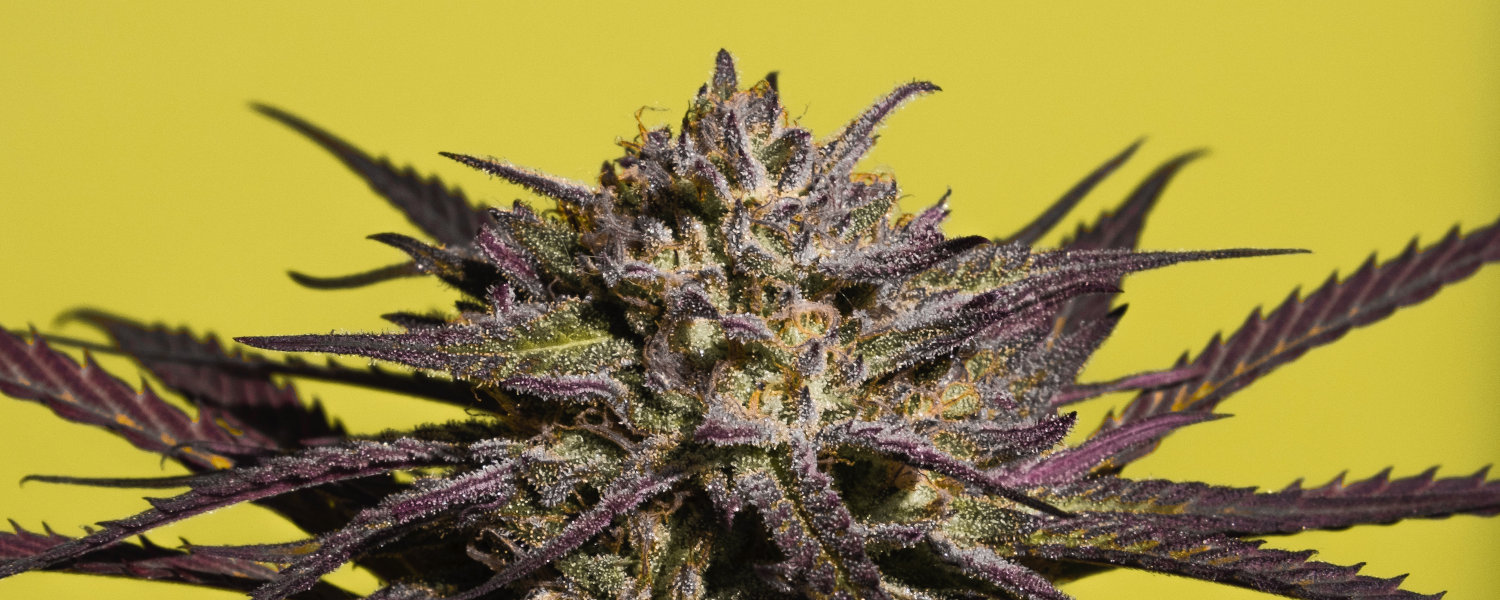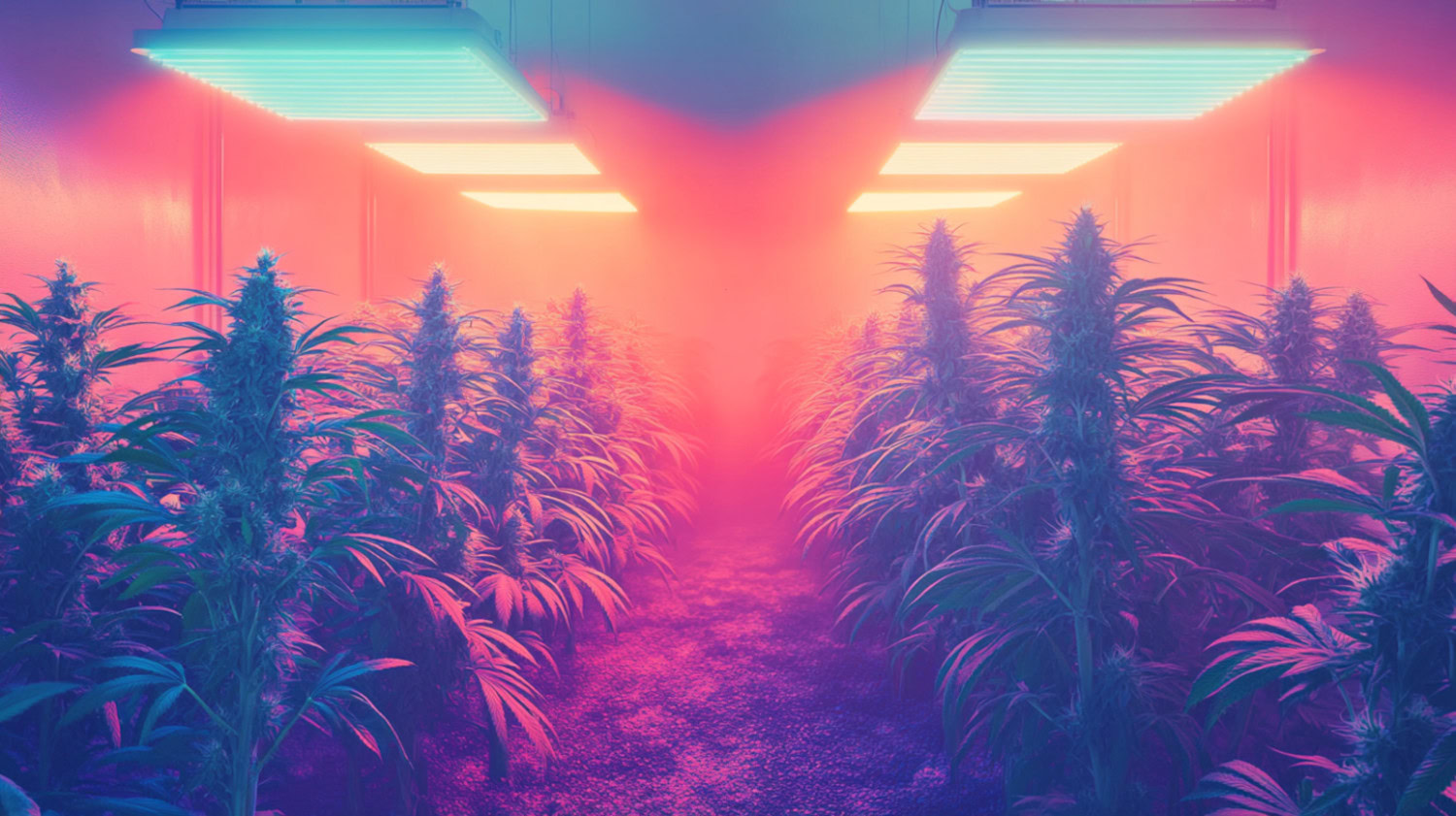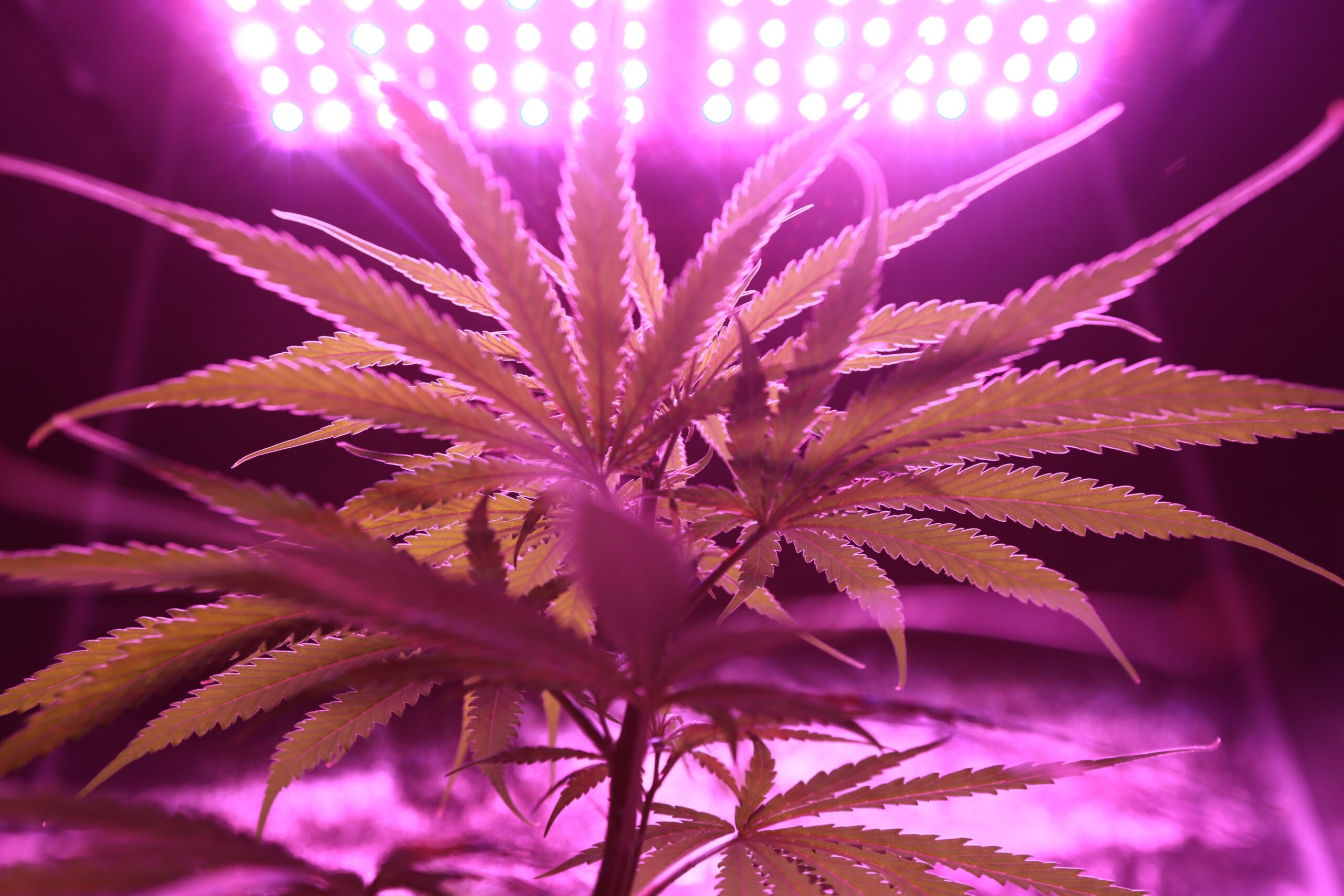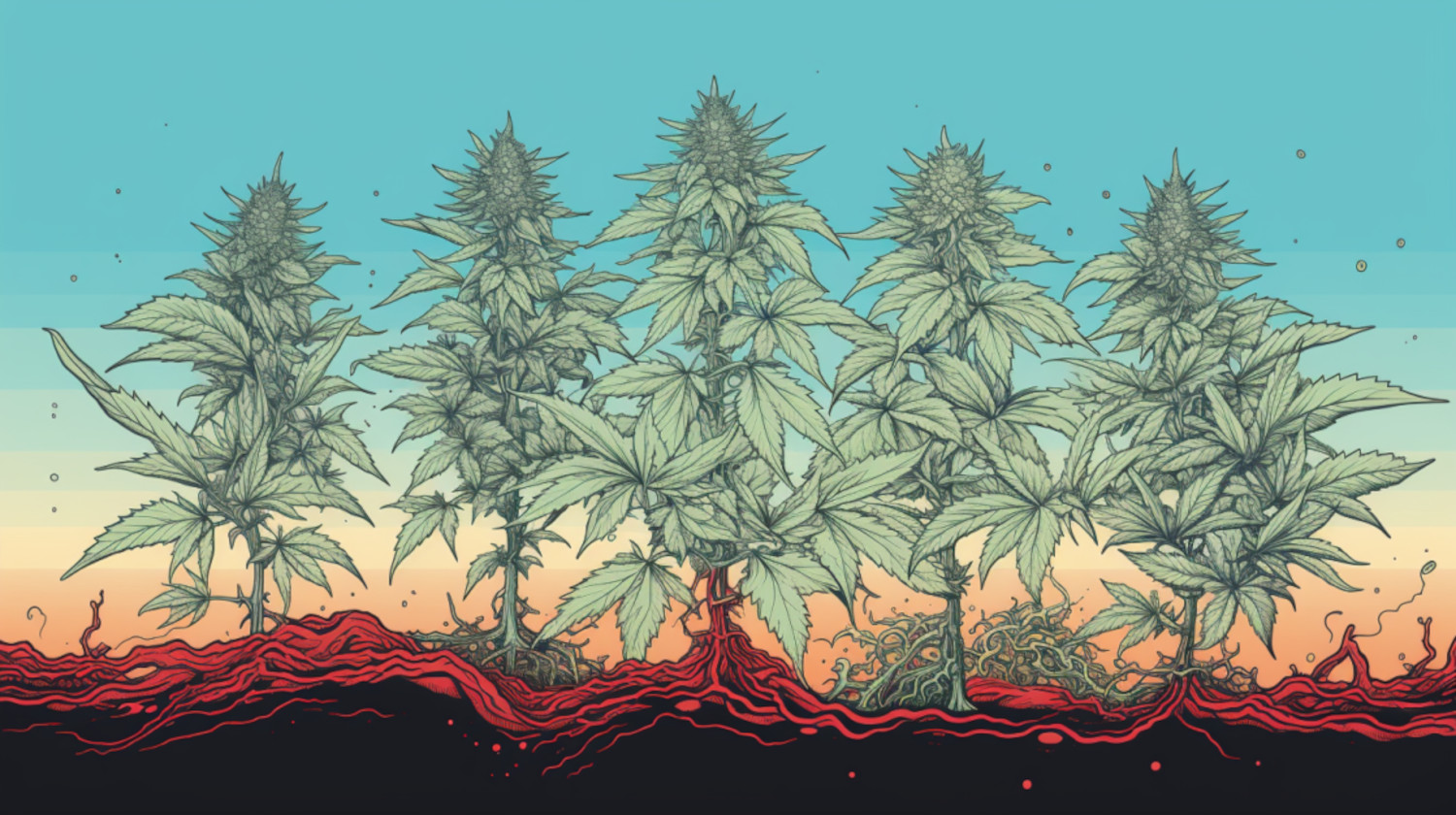Purple cannabis is one of the most popular and revered marijuana products out there. It is highly beloved for its vibrant purple leaves and buds.
Many cannabis consumers question if purple weed is really “better” than other weed strains or colors.
In this article, we’ll take a closer look into the allure of purple weed, the science behind why leaves turn purple, and provide tips on growing your own purple cannabis.
What is Purple Cannabis?
Purple cannabis refers to marijuana characterized by its striking purple leaves and buds.
Cannabis can change color because of anthocyanin, a pigment found in plants that produces red, purple, and blue hues often seen in fruits, vegetables, and flowers.
This color change can indicate a cannabis plant that is healthy and ready for harvest.
To produce purple weed, environmental factors such as temperature and light must be monitored and controlled to influence its level of anthocyanin. Colder temperatures, for instance, can cause cannabis leaves to turn purple, as can exposure to UV rays.
For decades, cannabis lovers considered purple cannabis highly desirable for its unique appearance. But does this color change really affect the flavor or effects of the final product?
Why Do Cannabis Leaves Turn Purple?
Cannabis sometimes turns purple due to an increase in anthocyanins, a group of pigments that may appear red, purple, or blue.
Besides environmental stressors, certain enzymes and nutrients influence the presence of anthocyanins. As the plant matures (known as leaf senescence), it produces these pigments in the leaves, stems, and buds. This creates the characteristic purple color.
Anthocyanins are also known for their antioxidant properties that help protect against environmental stressors such as UV radiation and extreme temperatures. They also play a role in pollination, as vibrant colors attract pollinators.
While purple leaves are often associated with high-quality or premium cannabis strains, the color change alone doesn’t necessarily indicate the plant is of higher quality. However, it’s a good sign of the plant’s maturity and readiness for harvest.
What are the Effects of Higher Anthocyanin in Purple Cannabis?
While purple weed may be visually striking and rare, there is limited research on the specific effects on the flavor or potency of the final product.
Several studies have shown therapeutic potential for higher levels of anthocyanins. However, much of the research on the therapeutic effects is still in its early stages, and we need more research to fully understand them.
Some of the therapeutic effects of anthocyanins in purple weed that have been proposed include:
- Anti-inflammatory: Anthocyanins have been shown to have anti-inflammatory properties,1 which may help to reduce pain and inflammation associated with certain conditions.
- Antioxidant: Anthocyanins are known to act as powerful antioxidants.2 These properties help protect your cells from damage caused by free radicals3 and may help to reduce the risk of certain diseases.
- Neuroprotective: Some studies have suggested that anthocyanins may have neuroprotective effects4 and may help to protect against neurodegenerative diseases such as Alzheimer’s and Parkinson’s disease.
- Cardioprotective: They may also have cardioprotective effects,5 which could reduce the risk of heart disease and stroke.
- Improved visual appeal: Consumers can highly value purple cannabis plants for their unique and visually striking appearance.
- Enhanced flavor profile: Some purple strains have sweeter, fruity, or floral notes because of the presence of anthocyanins.
Still, anthocyanins in your purple weed may also have some negative trade-offs:
- Lower THC levels: Cultivators often specifically breed purple cannabis strains to produce high levels of anthocyanins, which can lead to lower THC levels. Anthocyanin production is more common at colder temperatures,6 and plants exposed to colder temps to bring out the purple pigmentation may have lower THC.7
- Reduced yield: Purple cannabis strains may produce lower yields8 than other strains.
It is worth mentioning that the effects of purple cannabis can differ depending on the specific strain, growing conditions, and the individual consumer.
Some people may find that purple strains have a more pleasant or unique flavor profile. Others may not notice a difference in taste. Some consumers may prefer purple weed for its unique and luxurious aesthetics, while others may not care about the appearance of their cannabis.
5 Popular Purple Weed Strains
Dozens of weed strains often turn purple. Here are some of our personal favorites.
- Purple Haze: Many cannabis connoisseurs love this classic strain for its striking purple hues and energetic, euphoric effects. It has a sweet, earthy aroma and smooth, sweet smoke. It’s commonly used for stress relief and creativity enhancement.
- Sunset Sherbert: Some phenotypes of this indica-dominant strain are known for their deep, vibrant purple hues and sweet, fruity aroma. It has a smooth, creamy flavor with a hint of berry and citrus. It’s commonly used for relaxation, stress relief, and treating depression.
- Grape Ape: This Indica-dominant strain is known for its visually striking purple hues and grape-like aroma. It has a sweet, grape-like taste with a hint of earthiness. It’s commonly used for relaxation, pain relief, and insomnia.
- Granddaddy Purple: This Indica-dominant strain is one of the most popular indica strains and the most well-known purple weed strains. It’s beloved for its dramatic purple hues and relaxing sedative effects. Granddaddy Purp has a sweet, grape-like aroma and a fruity, berry-like taste. It’s commonly used for pain relief, stress relief, and insomnia.
- Tropicana Cookies: This strain is a hybrid between Tangie and Girl Scout Cookies sought after for its unique flavor profile and attractive purple core. It has a fruity, cookie-like taste with a hint of spice. It’s commonly used for relaxation, stress relief, and appetite stimulation.
Keep in mind that many cannabis cultivators may have “purple” strains, such as “purple afghani” and “purple tangie.”
Still, it’s important to remember that just because a strain has purple in the name or has purple hues doesn’t mean it’s more potent.
If choosing which strains to grow based on potency, it’s important to consider genetics, terpenes, and other characteristics.
How to Grow Purple Weed
Growing purple weed can be challenging and rewarding. Several requirements need to be met to increase the chances of the leaves turning purple, starting with the right strain, light, and temperature conditions.
Here’s how to grow purple weed:
- Choose the right strain: First and foremost, you’ll need to choose a strain that has the potential to turn purple. The ones we listed above have the potential to turn purple, but there are many others to choose from.
- Control the temperature: To bring out the purple hues, expose the plants to cooler temperatures, ideally between 55-70 degrees Fahrenheit. You can achieve this by using a cooling system or moving the plants to a colder area during the late flowering stage.
- Adjust the light: Like temperature, weed plants need specific light requirements to turn purple later in their growth. Exposing the plants to UV light can bring out purple hues. You can do this easily by using special UV-B bulbs or by moving the plants to an area that receives natural UV light, such as outdoors or near a sunny window.
- Monitor and adjust the pH levels: Proper pH levels are crucial for the plant’s overall health, which is ultimately necessary for the development of purple hues. It’s essential to monitor the pH levels of the soil and the water and adjust them to the appropriate range (6.0-7.0).
- Cultivate with care: Growing purple weed requires patience and attention to detail. It’s essential to provide the plants with the proper nutrients, humidity, and CO2 levels and to monitor them for pests and diseases.
- Harvest at the right time: Purple cannabis strains are typically ready for harvest when the buds have developed a deep purple hue and the leaves have yellowed. You must harvest the plant at the right time to ensure the best possible taste and potency.
By following these steps, cultivators can increase their chances of growing purple weed successfully. However, many factors can affect the color of your weed plants. Sometimes, producing these purple hues may not be possible.
Purple Weed FAQ
Is purple weed better than regular weed?
The quality of purple weed is not necessarily better or worse than green weed. The color of the cannabis is not the only indicator of quality, and the effects can vary depending on the genetic makeup, growing conditions, and cultivation methods.
Does purple weed cost more or sell for more?
Sometimes. Purple weed often commands higher prices, both to buy and sell, because of its unique appearance and the fact that it’s considered a rare or premium strain. However, the price can also depend on other factors, such as quality, location, and availability.
Can I grow any strain into purple cannabis?
No, unfortunately, not all strains have the potential to turn purple, so it’s crucial to choose a strain known for its ability to develop purple hues. Strains such as Purple Haze, Sherbert, Grape Ape, Granddaddy Purple, and Tropicana Cookies are well known for their purple hues.
Are there any purple sativas?
Purple hues are more commonly found in Indica strains, but some sativa strains also have the potential to turn purple. For example, Purple Haze and Tropicana Cookies are sativa-dominant strains known for their purple tones.
Can I turn weed purple by freezing it?
If the weed was already harvested, then no, it will not turn purple if you freeze it. In fact, freezing your weed may destroy many of the potent trichomes on your bud, lowering the potency.
While it’s true that exposure to colder temperatures can boost anthocyanin production and bring out the purple hues, freezing your marijuana plants will damage or kill them. The ideal temperature range for boosting anthocyanins in cannabis plants is between 55-65°F (13-18°C) during the late stages of flowering.
Can low nutrients cause purple weed leaves?
Low levels of certain nutrients, such as magnesium, nitrogen, and phosphorus, can cause purple or red pigmentation in the leaves of cannabis plants. This is because a lack of certain nutrients can cause stress to the plant, which can trigger the production of anthocyanins as a protective mechanism.
Does purple cannabis demand more care than growing regular cannabis?
Growing purple weed can be more challenging than growing regular weed, as it requires a specific combination of temperature, light, and nutrients to bring out the purple hues. It’s important to pay extra attention to the plant’s overall health and development to ensure the best possible yield and quality.
Sources:
1. Ma, Zilong, et al. “An Insight into Anti-Inflammatory Activities and Inflammation Related Diseases of Anthocyanins: A Review of Both in Vivo and in Vitro Investigations.” International Journal of Molecular Sciences, vol. 22, no. 20, 14 Oct. 2021, p. 11076, www.ncbi.nlm.nih.gov/pmc/articles/PMC8540239/, 10.3390/ijms222011076.
2. Tena, Noelia, et al. “State of the Art of Anthocyanins: Antioxidant Activity, Sources, Bioavailability, and Therapeutic Effect in Human Health.” Antioxidants, vol. 9, no. 5, 23 May 2020, p. 451, 10.3390/antiox9050451.
3. Lobo, V, et al. “Free Radicals, Antioxidants and Functional Foods: Impact on Human Health.” Pharmacognosy Reviews, vol. 4, no. 8, 2010, pp. 118–126, www.ncbi.nlm.nih.gov/pmc/articles/PMC3249911/, 10.4103/0973-7847.70902.
4. Henriques, Joana F., et al. “The Anti-Neuroinflammatory Role of Anthocyanins and Their Metabolites for the Prevention and Treatment of Brain Disorders.” International Journal of Molecular Sciences, vol. 21, no. 22, 17 Nov. 2020, p. 8653, www.ncbi.nlm.nih.gov/pmc/articles/PMC7696928/, 10.3390/ijms21228653.
5. Xu, Lin, et al. “Anthocyanins, Anthocyanin-Rich Berries, and Cardiovascular Risks: Systematic Review and Meta-Analysis of 44 Randomized Controlled Trials and 15 Prospective Cohort Studies.” Https://Www.frontiersin.org/, 15 Dec. 2021, www.frontiersin.org/articles/10.3389/fnut.2021.747884/full.
6. Zhang, Wei, et al. “Effect of Temperature and Its Shift on Growth and Anthocyanin Production in Suspension Cultures of Strawberry Cells.” Plant Science, vol. 127, no. 2, Sept. 1997, pp. 207–214, 10.1016/s0168-9452(97)00124-6. Accessed 28 May 2020.
7. Olejar, Kenneth J., and Chad A. Kinney. “Evaluation of Thermo-Chemical Conversion Temperatures of Cannabinoid Acids in Hemp (Cannabis Sativa L.) Biomass by Pressurized Liquid Extraction.” Journal of Cannabis Research, vol. 3, no. 1, 31 Aug. 2021, 10.1186/s42238-021-00098-6. Accessed 7 Oct. 2021.
8. Backer, Rachel, et al. “Closing the Yield Gap for Cannabis: A Meta-Analysis of Factors Determining Cannabis Yield.” Frontiers in Plant Science, vol. 10, 24 Apr. 2019, 10.3389/fpls.2019.00495.
The information in this article and any included images or charts are for educational purposes only. This information is neither a substitute for, nor does it replace, professional legal advice or medical advice, diagnosis, or treatment. If you have any concerns or questions about laws, regulations, or your health, you should always consult with an attorney, physician or other licensed professional.




